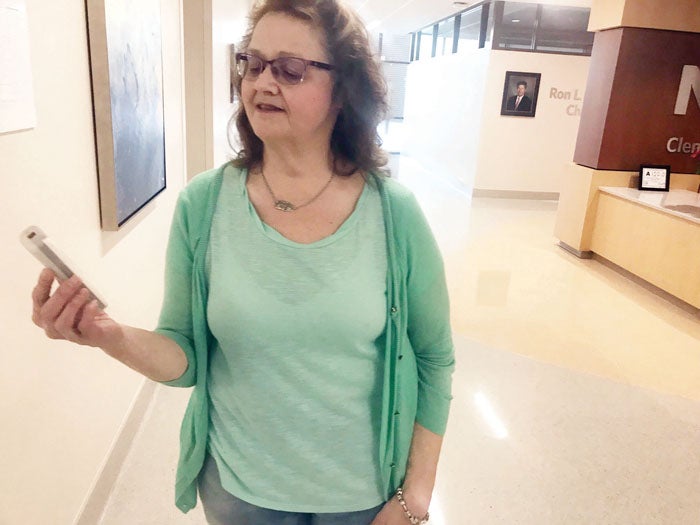Spinal stimulator can provide relief for patients in pain
Published 12:00 am Thursday, January 3, 2019

- Lauren Hurst has a spinal stimulator to provide relief for chronic leg pain caused by spinal problems.
Device allows former nurse to reduce medication, build new routines
Novant Health
Lauren Hurst had tried just about everything to feel better.
The 59-year-old woman from Clemmons had already undergone eight back surgeries in five years because her spine problems were causing severe leg pain. She also had surgeries done on both knees.
The combined pain from chronic conditions and other procedures made her miserable. She was referred to a pain clinic (not affiliated with Novant Health), where she encountered more frustration. Hurst said providers there always seemed to be prescribing more and more pain pills, without seeming to give thought to possible consequences.
Enough, she decided.
As a longtime emergency room nurse before her conditions sidelined her, Hurst knew she needed to find a better solution. The decision led her to Dr. Jeffrey Peacock of Novant Health Spine Specialists in Winston-Salem where a spine procedure finally put her on the right path.
“He was the first doctor who agreed with me that all of these dangerous pain pills were not going to be a long-term solution,” Hurst said.
Finally, her concerns were being heard.
A fresh look at a complex case
Peacock, an anesthesiologist and pain management specialist, said he approached Hurst’s case in early 2018 with an open mind.
At the time, Hurst could only stand for about 15 minutes before unbearable pain set in. She suffers from related conditions that include spinal stenosis, nerve impingement, scoliosis, rheumatoid arthritis and failed back surgery syndrome (FBSS). Spinal stenosis is a narrowing of the spaces within the spine that puts pressure on the nerves. Scoliosis is a condition that causes the spine to curve sideways.
On their first meeting, Peacock and Hurst discussed treatment options, such as injections and surgeries, but landed on spinal cord stimulation (SCS) as potentially the best choice.
Spinal cord stimulation was first developed in the 1960s. But there’s been an emphasis on improving the technology in recent years as researchers have looked for ways to treat people’s pain without using pain medicine, Peacock said.
The procedure works to block pain signals before they get to the brain. First, there is a one-week trial period to determine if the procedure would be a good fit for the patient. If it is, they proceed with a minimally-invasive surgery.
With the patient under sedation, the stimulator is implanted under the skin, where it delivers an electrical current to the spinal cord. The current is then felt by the injured nerves and prevents your brain from feeling the pain. Patients have a remote control they can use to adjust the stimulation.
“The way it works is you have this little buzzing and tingling in the area where you normally would have pain in your back and down your legs,” Peacock said. “Your brain focuses on the vibration…and you forget about all the pain that you’re in.”
There again for her family
Several months after her March 2018 surgery, Hurst has noticed big differences. While the underlying issues are still there, much of the pain isn’t felt in the same way and she can now concentrate better. She’s also taking far less pain medication.
Rather than feel intense pain after standing for just 15 minutes, Hurst can now go a few hours on her feet. While it’s not the 12 hours she managed as a full-time hospital nurse for over 30 years, it’s a big improvement. Unlike her other surgeries, she still feels the difference months down the road.
And Hurst said she’s begun to find new routines that make her happy. She’s able to make a meal for her family, eat at a restaurant without being distracted by pain and just spend quality time with her husband, Don, and their two adult sons when they’re together.
One of their sons, Sam, is blind and has autism and requires 24-hour care from Hurst and her husband. Having Hurst feeling better helps that dynamic, too.
“I love being able to stand up and just do day-to-day tasks again as long as I pace myself,” Hurst said. “I really love to cook, and now I can make dinner for my family and try to remember, like everyone else, not to overdo it for the holidays.”


